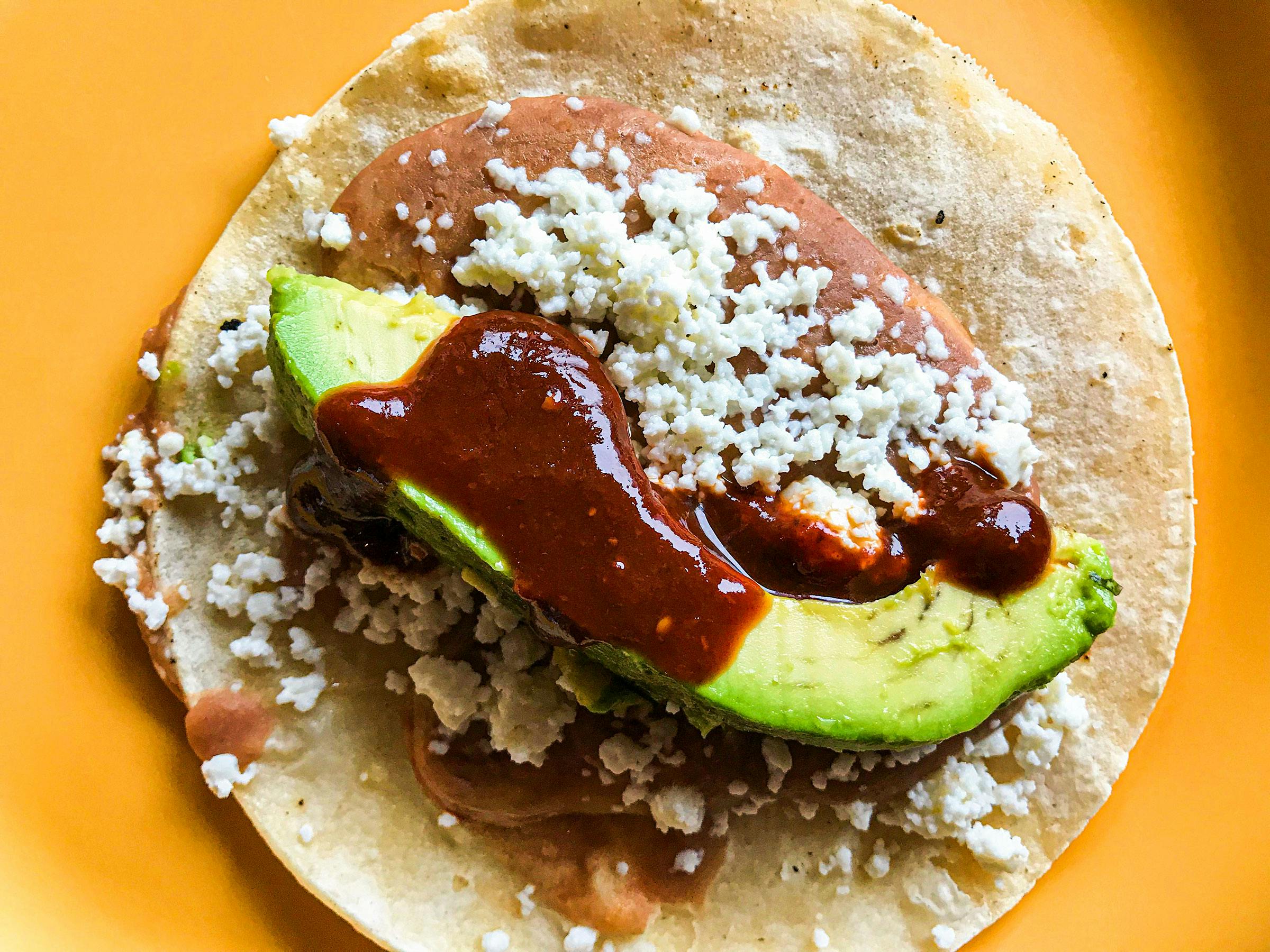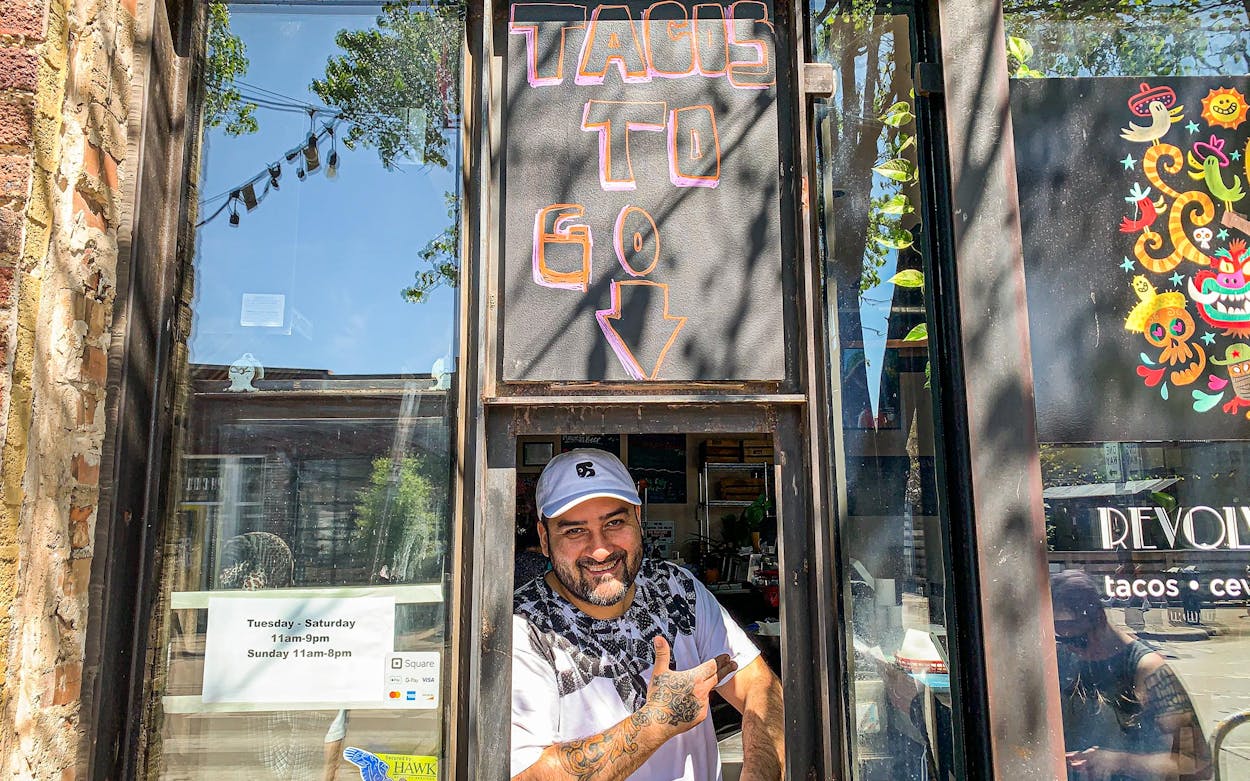When I worked for a Dallas-based magazine with offices at Lovers Lane and Greenville Avenue, near Southern Methodist University, I frequented El Come Taco. The taqueria, whose name roughly translates to “The Place to Eat a Taco” or “Eat a Taco,” was a ten-minute drive from my desk. I was there on its first day of business in 2013, when Luis Villalva and his brother, Javier, opened the small taqueria.
El Come Taco’s logo, a bright pink-and-white circle, centers a Mexican calavera (skull) and emphasizes the spot’s Mexico City–style food. The restaurant’s interior has a brick wall to the right. The other walls are plastered and painted pink and neon green. There are televisions tuned to soccer matches, and electronic music plays over the sound system. The white ordering counter, managed by younger Villalva sibling Vanessa, is decorated with pastel calaveras and lit by color-changing bulbs. A trompo is visible in the corner of the kitchen. The menu, written in chalk above the counter, is a list of familiar street cart and taqueria hits from Mexico’s capital: suadero, campechanos, tacos al pastor, cabeza, tortas, and more.
The pairing of modern design and familiar, traditional tacos that regularly go for more than $2 hits a sweet spot for the taqueria co-owned by the Villalvas and employing much of their family. Construction workers, office suits, taco enthusiasts, food industry veterans, and Mexican immigrants pining for a taste of home waited patiently in line to order at the counter. El Come Taco made Texas Monthly’s 2015 taco list, and I’d planned to include it in last year’s Ultimate Texas Tacopedia. Then this family-owned taqueria was sucker-punched.
On March 16, 2020, restaurant dining rooms in Dallas county closed for indoor service. Chefs were forced to conjure new business plans overnight. On a visit to El Come Taco late last summer, I found a reimagined business. The dining room was locked and a section of the front window had been replaced with a to-go taco window, complete with a vinyl shield protecting the employee taking orders. In my case, it was Luis’s wife, Liz. The reconfiguration, which included the menu pasted on the rest of the window, was installed in late April to save the business. Without it, El Come Taco would have permanently closed, Luis Villalva told me. And while the taqueria’s dining room has reopened at 50 percent capacity for now, the restaurant’s original counter service has been replaced with table service. The window remains in operation, and it’s brought in enough revenue to keep the lights on and the trompo spinning.

I ordered my tacos and took them to the trunk of my car. One Styrofoam clamshell container bore a supple cabeza taco topped with the house specialty of cubed potatoes and nopales. It was great, but my favorite was the José, named for Luis’s father. The dish is simple but full of comforting flavor: a couple of tortillas are slathered with creamy refried beans, a dousing of queso fresco, and a wedge of avocado. With this taco, Luis says, he’s paying tribute to his dad, who made sure Luis, Liz, and the couple’s two sons had food and other necessities when Luis was diagnosed with COVID-19 last year. Thankfully, he suffered only minor symptoms. “It felt like I had worked a really hard, long week,” he told me, before warning that the disease is nothing to take lightly. “It’s been a f—ing year, man,” he said.
Through it all, the restaurant remained open. Walk-up sales at the window have been critical. “The window is not going away,” Villalva, a stout, balding gentleman with a thick, black beard, told me during an early January phone call. “I had decided before the pandemic that if I were to ever open a second place, it would be a window.”
Windows are cheaper to operate than dine-in service, especially since the cashier can double as the cook. It’s a smaller footprint. An existing window might easily and affordably be converted into such a fixture. Villalva isn’t alone—dozens of other Texas restaurants also added window service during the pandemic. Since this option can be easily operated in addition to dine-in-service, there’s no reason to eliminate it once the pandemic ends. The taco window is the future.
This isn’t exactly a new innovation, though. The taco window has long been a fixture of taco culture, from Mexico City’s famed El Huequito to Dallas’s Fuel City chain and other gas station taquerias. Such operations permit greater flexibility. Through a window you can sling basics such as pork-beef-chicken, or specialize in regional delights, as with the tacos de canasta at Taco Canasta. The same chile that’s used in a guisado, or stew, could also slather a tortilla for enchiladas. Chorizo for one preparation can be combined with eggs for breakfast tacos. The taco window is safe and smart. It also may be vulnerable to racist and anti-immigrant stereotypes: It’s only a matter of time until we see a restaurant review—whether from an establishment critic, Yelper, or Instagram influencer—praising a window operation’s “hole-in-the-wall authenticity” or its penchant for serving the “humble taco”—offensive phrases that give me chills.
One thing is clear: the taco window is a lifeline. It kept Revolver Taco Lounge afloat until owner Regino Rojas could open his La Resistencia concept. Trompo in Oak Cliff did something similar and is on the verge of opening a second location in East Dallas. In Fort Worth, fifty-year-old Tex-Mex joint Jesús Barbecue closed its dining room and converted a side door into a takeout window to protect nonagenarian owner Jesús Borja from catching the virus. In Austin, Vaquero Taquero pivoted to a window setup early in the pandemic. It was a part of the initial design of Taconeta in El Paso. Carnitas Lonja in San Antonio takes orders only via a window. There are myriad other examples across the state.
A window saved San Antonio’s excellent Con Huevos Tacos. Owner Hugo Garcia says his breakfast taco spot’s window is responsible for returning his restaurant to profitability after it struggled during the early months of the pandemic. The tiny window on the side of the small freestanding restaurant was already installed when Garcia rented the building and opened in November 2019. We know what happened next. “The window and COVID went hand in hand,” the taquero told me. The fixture has been so lucrative for Con Huevos that Garcia is considering adding a dinner service that will utilize a remodeled patio. He puts it plainly: “In the future, anybody who wants to open another restaurant has to be thinking about [windows]. One hundred percent.”
- More About:
- Tacos
- San Antonio
- El Paso
- Dallas








